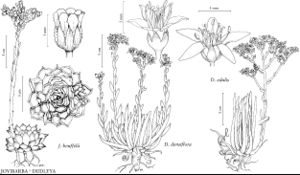Jovibarba
Seznam, 54. 1852 ,.
| Taxon | Illustrator ⠉ | |
|---|---|---|
 | Jovibarba Jovibarba heuffelii Dudleya densiflora Dudleya edulis | Yevonn Wilson-Ramsey Yevonn Wilson-Ramsey Yevonn Wilson-Ramsey Yevonn Wilson-Ramsey |
Herbs, perennial, monocarpic, not viviparous, 0.8–2.5 dm, glabrous. Stems erect, (compressed), not branched, succulent. Leaves persistent, forming basal rosette, alternate, sessile, not connate basally; blade oblong to obovate, laminar, 2–4 (–6) cm, succulent, base not spurred, margins entire, sometimes ciliate; veins not conspicuous. Inflorescences terminal cymes. Pedicels absent or to 1 mm. Flowers erect, 6–7-merous; sepals connate basally, all alike; petals erect, distinct, greenish white or greenish yellow to yellow, margins fimbrillate; calyx and corolla not circumscissile in fruit; nectary disc quadrate; stamens 2 times as many as sepals; filaments not adnate to petals; pistils erect, connate; ovary base rounded; styles 4–5 times shorter than ovary. Fruits capsular, erect, composed of basally connate pistils. Seeds (brown), ellipsoid, ribbed. x = 19.
Distribution
Introduced; Wis., Europe, Asia
Discussion
Sempervivum Linnaeus sect. Jovibarba de Candolle in A. P. de Candolle and A. L. P. P. de Candolle, Prodr. 3: 413. 1828
Species 3 (1 in the flora).
Segregation of Jovibarba from Sempervivum has been problematic and uncertain for over a century. The uncertainty has centered upon whether Jovibarba should be treated as a section of Sempervivum or as a genus. Recent work has shown that the two are closely related (M. E. Mort et al. 2001). J. Parnell and C. Favarger (1992) maintained Jovibarba at the generic level; H. ’t Hart et al. (2003) treated it at sectional rank within Sempervivum. R. C. H. J. van Ham and ’t Hart (1998) did not include any accessions of Jovibarba in their study of the Crassulaceae using chloroplast DNA.
Taxa assigned to Jovibarba generally have been segregated from Sempervivum based on: (1) the erect petals in Jovibarba versus reflexed petals in Sempervivum; (2) 6(–7)-merous flowers in Jovibarba versus 8–16-merous flowers in Sempervivum; (3) fimbrillate petals in Jovibarba versus entire petals in Sempervivum. J. Parnell (1991) examined pollen morphology and ultrastructure and found significant differences between Jovibarba and Sempervivum and concluded that these palynological differences supported retention of Jovibarba at the generic level. H. ’t Hart et al. (2003) discussed their decision to submerge Jovibarba into Sempervivum and discounted the floral morphology differences as being insignificant relative to similarities. They did not discuss, or cite, the palynological differences presented by Parnell, which are congruent with the character-state differences in floral morphology, and support segregation of Jovibarba from Sempervivum.
Selected References
None.